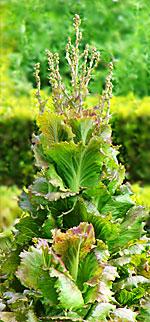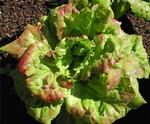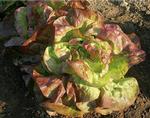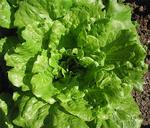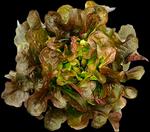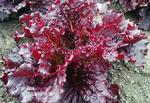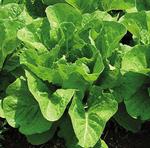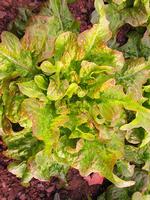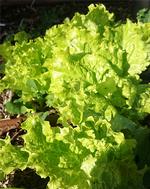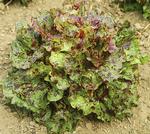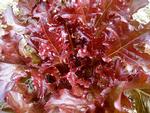Growing Lettuce in Warm Weather
Home » Fair Oaks Horticulture Center » Vegetables » Lettuce in Summer

| Lettuce is not usually a vegetable we think of when planning a summer garden in the Sacramento area. It is a cool season vegetable, sensitive to high temperatures and dry soil. In the vegetable garden at the Fair Oaks Horticulture Center during the summers of 2015 and 2016, we decided to take on the challenge of demonstrating what it takes to grow those beautiful green and red leaves for salads and sandwiches. High temperatures and how lettuce responds to them are the biggest factors to deal with. Lettuce seeds germinate poorly in warm summer soil since heat may cause seed dormancy. Lettuce may bolt in response to the stress of high temperatures, and the leaves may become bitter as the plant puts its growth into flowering (see photo at right). Leaves wilt, toughen, and get bitter if the plant becomes water stressed in heat. We used the following techniques to successfully grow lettuce in warm weather: |
Meet the Heat Challenge
- Grow loose leaf varieties that are heat-resistant or slow-bolting, rather than varieties that form heads. We had success with 'Jericho', 'Red Cross', 'Nevada', 'Paradai', 'Merlot', and 'Year Round Bronze Oak Leaf'. See them in green text in the tables below.
- Use transplants or germinate seeds indoors in containers away from heat.
- Provide shade. Use shade cloth or plant on the shady side of taller vegetables.
- Don't skimp on water. Keep lettuce growing fast to prevent wilting, premature bolting, and bitterness.
- Mulch lightly with an organic mulch to retain soil moisture.
Maintenance Keeps the Harvest Going
- Use cut-and-come-again harvesting of outer leaves.
- Make successive plantings with transplants to replace spent plants.
- During the season, replenish soil nitrogen to encourage growth. We used a mild liquid fish emulsion fertilizer.
- Inspect plants for insects and diseases. Hand pick and destroy destructive insects. Remove diseased leaves or plants.
- A light organic mulch keeps leaves off the ground.
For Additional Information:
- Vegetable Gardening 101 (EHN 96) for basic vegetable gardening information
- UC Davis Vegetable Research and Information Center, Home Vegetable Gardening, Recommended varieties and problem diagnosis
- Find seed sources online by searching on the plant names.
Varieties We Grew in Summer--How Did They Do?
2015
(Bold/italics indicates successful varieties)
| Variety (Pics Enlarge) |
Date Transplanted | Days to Bolting | Comments |
| April 15 | 21 | Red iceberg type Bolted week of 106° heat |
|
| April 15 May 27 |
77 | Loose leaf; edges singed in full sun | |
| May 15 | 42 | Batavian summer lettuce | |
| May 20 July 7 |
28 | Bolted week of 106° heat | |
| May 15 | 42 | Dense heads of ruffled red leaves | |
| April 15 July 7 |
73 | Romaine variety from Israel | |
| July 15 | 40+ | Had not bolted by time of removal |
2016
(Bold/italics indicates successful varieties)
| Variety | Date Transplanted | Days to Bolting | Comments |
| June 1 | 32 | Loose leaf, lime green color Bolted week of 107° heat |
|
| June 1 | 29 | Bolted week of 107° heat | |
| June 1 | 60+ | Dense heads of ruffled red leaves | |
| June 1 | 32 | Bolted week of 107° heat | |
| June 1 | 43 | Developed locally at Rudolph Steiner College |
Author: Kathy Baker, UCCE Master Gardener of Sacramento County




